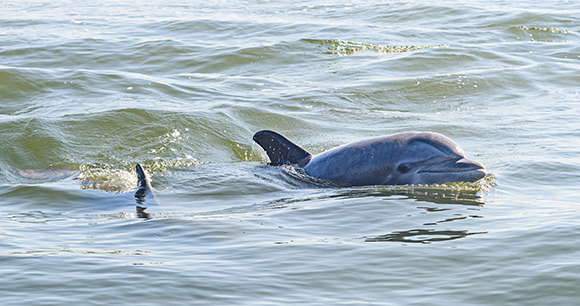Hurricane Katrina in 2005 gave the US coast along the Gulf of Mexico a preview of things to come, as severe weather worsens with climate change. In addition, decades of flood control along the Mississippi River has changed the coastline tremendously, leading to an erosion of land and loss of wetlands and marshes. These natural buffers against storm surge and damage during hurricanes have been disappearing, and the results during Katrina were devastating.

Then came the Deepwater Horizon oil spill in 2010. Again, natural coastal features would have detoxified some of the spill, had they been left in place, but their loss clarified for many the crisis facing fisheries, tourism, other economic sectors, and wildlife—all of which rely on a healthy Gulf ecosystem. It was clear something had to be done. “Restore the Gulf” became a rallying cry in the region, and authorities are now planning ambitious efforts intended to undo some of the intensely negative effects of “taming” the mighty Mississippi over the past 100–150 years.
One such effort involves diverting sediment, freshwater, and nutrients from the river to rebuild land that has eroded over the years. Massive diversion complexes, including channels and outfall areas, would be built at specific points along the river, allowing sediment, during times of high water, to flow into areas long cut off from this important riverine resource. Wetlands and marshes would be restored in a controlled manner, using semi-natural processes over the course of decades.
The first such project slated to move forward is the Mid-Barataria Sediment Diversion (MBSD). The project’s goal is to rebuild approximately 20 square miles of land in Barataria Bay, Louisiana, over the next 50 years. During certain high water periods, when the Mississippi River would normally flood, sediment-rich water would be channeled at a specific location (near Myrtle Grove, within Plaquemines Parish) into Barataria Bay, changing the salinity and nutrient composition of the bay to replace open salty water with brackish marshes.
There is widespread support for this project within the environmental community, but strong opposition also exists. Absent many decades of natural flood processes of the river, Barataria Bay has become host not only to commercial and recreational fisheries that are of great value to the local community economically, but also to a population of some 2,000 bottlenose dolphins, which constitute a distinct stock under the US Marine Mammal Protection Act (MMPA). The Barataria Bay dolphins were already hard hit by the Deepwater Horizon spill; the MBSD project will do yet more damage, as dolphins are strongly and negatively affected by prolonged exposure to low salinity. AWI and groups that are specifically focused on the protection of wildlife have spoken out against this project. While restoring wetlands and marshes in the Gulf is a laudable and important goal, doing so while harming—even killing—hundreds of dolphins is simply unacceptable.
This impact would be so severe, and on a stock already suffering negative effects from a previous environmental disaster, that under normal circumstances, the MBSD project would never have received authorization to proceed under the MMPA. When it became clear to the project leaders that they could not receive permission under the law, they considered seeking a waiver to the MMPA. Waivers provide a way for activities otherwise disallowed under this precautionary statute to proceed, while still maintaining some level of protection for affected marine mammal populations. This regulatory process is rarely pursued, however, as it is (rightfully) onerous and restrictive.
The MBSD project proponents, in fact, realized that the normal waiver process could potentially take years, and there was no guarantee a waiver would be granted in the end. Therefore, in early 2018, they sought a legislative waiver to the MMPA—inserting language into a must-pass budget bill that would mandate issuance of a waiver for three specific diversion projects, including the MBSD, completely bypassing the regulatory process. This drastic end-run around the MMPA sets a very dangerous precedent that other entities, with far less noble intent, might seek to exploit. Nevertheless, the budget bill passed in February 2018 and the waiver was issued one month later. The project prepared its environmental impact statement (EIS) as required under the National Environmental Policy Act, publishing the draft EIS in March 2021.
The flaws in issuing a legislative waiver became fully apparent when this EIS went out for public comment. Models predict the Barataria Bay dolphin stock will be effectively wiped out by the end of the 50-year operation of the diversion structure. Instead of the current 2,000 or so dolphins recovering slowly to about 3,300 dolphins by 2070, only about 140 dolphins are predicted to remain by that year under this project. These survivors will persist mostly along the barrier islands at the entrance to the bay, where dolphins would be exposed to enough salt water from the Gulf to survive the lowered salinity within the bay. (It might seem odd that the dolphins would remain in the bay once conditions deteriorate, but dolphins tend to be highly site faithful and are unlikely to relocate, regardless of the diminished suitability of their habitat and their poor health. Even those few who do venture to escape the bay’s ever-lowering salinity would be in competition with neighboring dolphin stocks and unlikely to thrive.)
In short, because authorities could not impose the requirements and restrictions of the MMPA, this project is attempting to restore approximately 20 square miles of land at the cost of thousands of dolphins’ lives.
AWI and other organizations submitted comments on the draft EIS, urging the Army Corps of Engineers and the project leaders to rethink their approach to Gulf restoration. The Marine Mammal Commission also submitted comments in opposition, noting that even the minimal mitigation required under the legislative waiver has not been applied. Simply put, the ends do not justify the means. Legislative waivers to environmental statutes should never be used to allow wholesale killing of entire populations of wildlife, even when the purpose—in this case, to mitigate climate change and coastal erosion—is otherwise desirable.